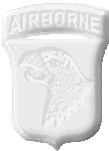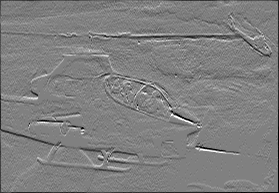
| ABOUT | SIGN IN | ROSTER | HOME | KIA's |

In 1969 I was an AH-1G Cobra pilot for B 2/17 Air Calvary attached to the 101st Airborne Division, stationed at Camp Eagle, South Vietnam. Camp Eagle was a major U.S. base and the division headquarters for the 101st. The camp was located southwest of Hue and northwest of Phu Bai on the coastal plain. B Troop carried out typical air cavalry responsibilities; i.e., general scouting, locating and engaging enemy units.
In the fall of 1969, our normal area of operations was a rough rectangle bordered on the south by the Hai Van pass near Da Nang the north by the old imperial city of Hue, and extending to the west about 25 miles to the Laotian border. Besides being mountainous and having triple canopy jungle, this area included both the A Shau and the Roung Roung Valleys. Both valleys were part of the North Vietnamese infiltration route commonly called the "Ho Chi Minh Trail". Once we flew west from the coastal plain, the entire area was a "free fire zone."
Standard operations for B Troop during my tenure was for "hunter- killer" teams composed of one Cobra and one OH-6A scout helicopter, to work specific locations within our Troop's area of operations. The small scout helicopter would hover above and around the trees reporting enemy facilities, activities and estimates of strength. The Cobra gunship would orbit above the scout, receive and transmit spot reports, engage suspected enemy targets and most importantly, provide close air support if the scout received ground fire.
Early in October, 1969 we were informed at a pilot's briefing that an AH-1G from D 158th Aviation Company (Redskin-27) had gone down in bad weather the previous evening; probably somewhere in our area of responsibility. The next several days, our main mission shifted to intensively searching our area to attempt to locate either pilots or wreckage from this incident. After this unsuccessful initial effort, we returned to our normal missions. However, we continued to see Hueys from the 158th gamely low leveling, up and down the mountain sides, peering into the jungle canopy in an attempt to locate their downed comrades.
On October 13, I was working a hunter killer mission with a scout flown by CW2 Ronald Peterson, in the mountains southeast of the A Shau. I received a call from our C.O. Major Garry Dolin, that an Air Force forward air controller thought he has seen a flashing mirror on the mountain ridges that defined both the western side of the A Shau valley and the Vietnam/Laotian border.
Major Dolin instructed us to rendezvous with his Huey over the valley. I called Peterson up to altitude and we proceeded to the west side of the A Shau. We fell in behind the Huey and proceeded to fly in a loose trail formation from south to north along the mountains and ridges that make up the west side of the valley. The Huey was in the lead at about 100 feet above the trees, the OH-6 was about 50 meters behind and also 100 feet and I was about 75 meters in the rear and about 150 feet. (Remember all those admonitions not to fly in the "Dead Man's Zone"?)
As we worked our way north, not surprisingly , Major Dolin repeatedly reported small arms fire and enemy personnel sightings. Even though these targets were available, I was unable to return fire since, of course, I did not know the proximity of the downed pilots. We safely completed the run to the north end of the valley, past "Hamburger Hill", disappointed by our lack of success, turned back to the east for our return to Camp Eagle.
On the northwest side of the A Shau, the mountains tumble down into numerous foothills and ridges leading to the valley floor. This area was the scene of intense fighting for many years and the jungle was perforated with numerous artillery and bomb craters. As we flew out over the foothills we were still in the same loose trail formation. That's when I did an unusual but fortuitous thing. For reasons I don't understand, I twisted to the right in my armored seat, craned my neck around the seat looked down and to the rear of my aircraft, and there was a person standing in a bomb clearing and waving a cloth at me. I started to bank to the right and called to Dolin that I had spotted something at 5 o'clock. By then I think the person in the little jungle crater had popped a smoke grenade. We quickly decided that the Huey would stay high, the scout would go in for the pick up, and I would slowly fly my Cobra above and behind the scout during the rescue to act as decoy and to discourage enemy fire.
Actually returning enemy fire from my Cobra would be almost out of the question since we assumed this was one of the missing Cobra pilots, but we were still unsure where the other pilot was. Much to our collective relief, the rescue turned out to be uneventful. Peterson made a fast but smooth landing and take off, then radioed that the rescued man's name was Capt. Robert Andrews, that he was the missing Cobra's aircraft commander and that he was in pretty desperate shape from numerous injuries. Peterson also said that Andrews reported crashing into the jungle in bad weather and that his copilot was dead. His copilot's body was apparently with the aircraft somewhere on the mountains to the west. Peterson proceeded to fly the injured pilot to the evac hospital at Phu Bai.
In December, 1970, when I was a test pilot for Project Massters at West Fort Hood, I unexpectedly received a Christmas card from Germany. Enclosed was a picture of Capt. Robert Andrews and his young son Daniel dressed in their finest Bavarian festival clothes. It was a good picture.
| *** | The history of the US involvement in the Viet Nam War, and the evolution of the combat helicopter, can be read in the wreckage and ashes littering the floor of the A Shau Valley | *** |
Thanks for the story of the rescue of Redskin 27 (Cpt. Andrews). After a combat extraction in the south end of the A Shau, fuel was critical. One of our slicks made a emergency landing on Firebase Charlie Brown as it ran out of fuel. I raced back to Eagle and "borrowed" a fuel pump and then returned to the downed bird. The fuel pump hose was too short and the bird was abandoned. Night was falling and a solid cloud bank moved over the east side of the A Shau. We climbed to 9,000 feet but the only way out was into the storm front (The abandoned bird was found untouched the next morning and flown out!). While returning, Redskin 27 almost had a midair with my slick (Ghostrider 66) under IFR night conditions. I broke right... they broke left and got vertigo and then ended up crashing into the jungle in Laos. I'll never forget the scream of my crew chief when he saw that cobra come at us out of the night.
The snake that crashed had a Captain in the back and a Warrant in the front. When they got vertigo they fought each other over the controls. After the rescue we had a battalion meeting at Evans where the BTN CO informed all warrants that from this point on RLOs were in command of all aircraft even if the warrant was an AC with years of experience.
